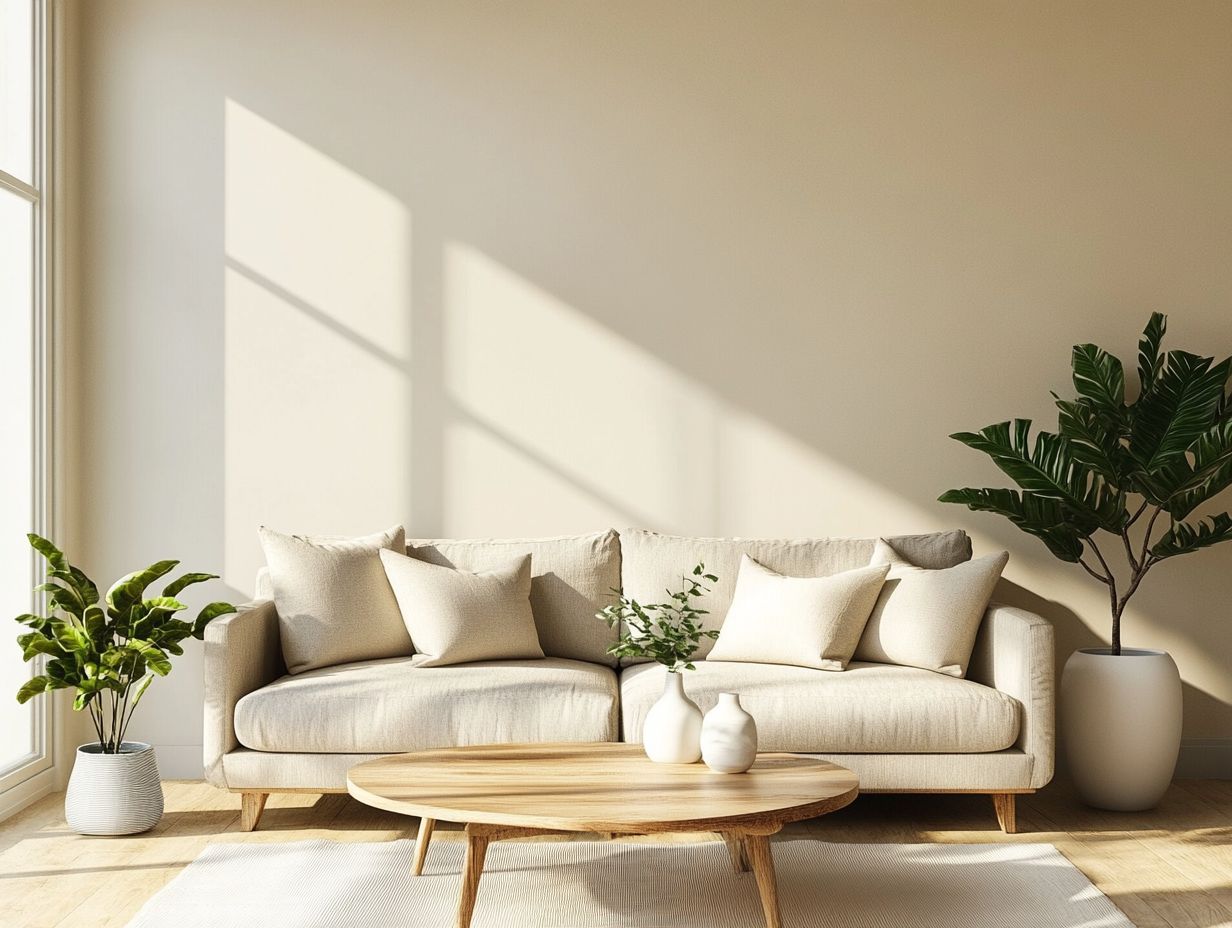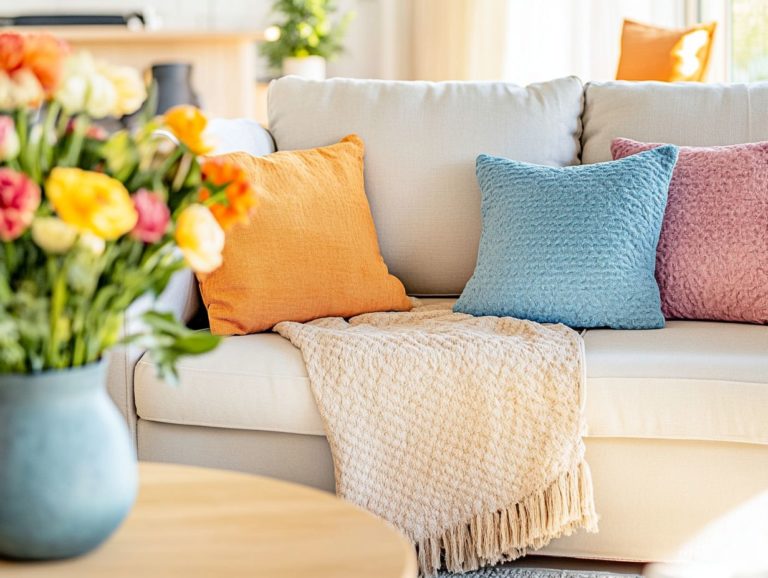How to Achieve a Neutral Palette for Staging
Staging your home effectively can transform the buyer experience. Using neutral color palettes is key to this endeavor.
By selecting soft, serene tones, you create an inviting atmosphere that encourages potential buyers to envision their own lives within the space. This guide will walk you through the essentials of choosing and incorporating neutral colors while adding your personal touch.
Discover how to turn your home into a canvas that attracts a broad audience and ensures your staging efforts yield the best possible results.
Contents
- Key Takeaways:
- The Importance of Neutral Palettes in Staging
- Choosing a Neutral Color Scheme
- How to Incorporate Neutral Colors into Your Home
- Creating a Balanced Look with Neutral Colors
- Using Pops of Color in a Neutral Palette
- Maintaining a Neutral Palette for Staging
- Tips for Keeping the Space Clean and Cohesive
- Frequently Asked Questions
- What is a neutral palette in home staging?
- Why is it important to achieve a neutral palette for staging?
- How can I choose the right neutral colors for staging?
- Can I add pops of color to a neutral palette for staging?
- What if my current d cor doesn’t fit a neutral palette?
- Here are more exciting tips to perfect your neutral palette!
Key Takeaways:

Neutral palettes create a blank canvas for potential buyers. Consider room size, natural light, and existing furnishings to unify your look. Incorporate different shades and textures of neutral colors, along with pops of color, to create a balanced and visually appealing space.
The Importance of Neutral Palettes in Staging
Neutral palettes are crucial in home staging, especially in competitive markets like Charleston. They establish a clean aesthetic, enabling buyers to envision their own style within spacious rooms.
First impressions often determine the success of a property sale. Using effective home staging, especially with services like MHM Professional Staging, can highlight selling points and ensure your property shines in online photos.
Why Neutral Colors are Preferred
Neutral colors are favored in home staging because they appeal to many potential buyers. They create an inviting atmosphere that elevates the property s overall allure.
These tones like light gray, beige, and cream work harmoniously to promote relaxation. Stepping into a space dressed in these shades evokes a sense of ease, sparking imagination about how personal belongings could fit into the home s elegance.
This tranquil backdrop not only highlights the property s architectural features but also fosters an emotional connection that can significantly boost interest and enhance the likelihood of a sale.
Choosing a Neutral Color Scheme
When choosing a neutral color scheme, select hues that complement your property s architecture and design. This creates an appealing environment that resonates with potential buyers.
Factors to Consider
When considering a neutral color palette for home staging, keep these factors in mind:
The lighting in each room affects how colors are perceived. Well-lit spaces enhance the warmth of soft beiges and gentle grays, creating an inviting atmosphere.
For larger areas, muted tones provide an elegant backdrop that complements various furniture styles, whether contemporary or rustic. In smaller rooms, lean towards lighter shades to create the illusion of space.
Successful palettes often include off-white or taupe, which attract young families or modern buyers. Warm undertones appeal to those seeking a cozy atmosphere, while cooler tones resonate with minimalist tastes.
How to Incorporate Neutral Colors into Your Home

Incorporating neutral colors is an art achieved through thoughtful painting, strategic furniture arrangement, and careful selection of accessories that enhance visual cohesion.
Each element plays a crucial role in creating a harmonious atmosphere that resonates with sophistication and tranquility.
Start staging your home today to attract buyers faster!
Painting and Accessorizing Tips
To elevate your space, embrace neutral colors for a unified look. Choose home accessories that add depth and personality without overwhelming the aesthetic.
Select the right paint finish. Matte finishes create a cozy vibe, while glossy options reflect light and give a contemporary feel.
When choosing accessories, consider how textures and shapes interact. Ensure each piece contributes to a harmonious design.
Plants freshen the air and bring vibrancy to your space. They add life and color that can make a significant difference.
Think about seasonal colors. Use warm oranges and rich browns for autumn, or cool blues and greens for spring through throw pillows or wall art.
These choices keep your space lively while maintaining balance.
Creating a Balanced Look with Neutral Colors
A balanced aesthetic with neutral colors requires blending various shades and textures. This careful combination enhances depth and adds captivating interest to your home.
Combining Different Shades and Textures
Mixing different shades and textures of neutral colors creates an inviting environment. It appeals to potential buyers while maintaining a cohesive look.
Layer textiles such as soft cotton throw pillows and plush wool rugs. This layering achieves visual depth that captivates the eye.
Wall treatments like textured wallpaper in warm beige or soft gray enhance the room’s ambiance. They provide a beautiful backdrop.
Using furnishings made from natural materials, like a reclaimed wood table, introduces an organic feel. This harmonizes beautifully with neutral colors.
This blend not only highlights the beauty of neutrals but also creates a welcoming atmosphere. It invites viewers to see themselves in the space.
Using Pops of Color in a Neutral Palette
Pops of color can energize your neutral palette. These vibrant accents draw attention and help buyers envision their style in the space.
Adding Interest and Personality

Pops of color can transform a neutral palette. They create an engaging atmosphere that resonates with buyers and leaves a lasting impression.
Use colorful accessories like vibrant throw pillows or striking artwork to elevate the space. A bold piece of wall art can become a focal point, drawing attention without overpowering.
Introduce colorful plants to breathe life into the space. They add subtle color and enhance the overall design.
Striking a balance is key; these elements should complement the decor. This promotes a sense of cohesion that invites buyers to envision themselves in the home.
Maintaining a Neutral Palette for Staging
Keeping a neutral palette during staging is crucial. It creates a clean and cohesive aesthetic that appeals to buyers and boosts the property’s value. For more tips, learn how to choose the right colors for staging.
A well-chosen color scheme enhances the atmosphere and allows buyers to see themselves in the space. Ultimately, it makes a lasting impression.
Tips for Keeping the Space Clean and Cohesive
To maintain a clean and cohesive neutral palette during home staging, regular upkeep and thoughtful organization are essential for crafting the best first impressions on potential buyers.
Establishing a consistent cleaning routine can greatly elevate the overall presentation of your space. This ensures that every corner sparkles and feels inviting.
By adopting practical strategies like removing unnecessary items from surfaces and prioritizing organization, you streamline the staging process and highlight the beauty of those neutral tones.
Minimizing personal items and keeping d cor understated creates a blank canvas. This enables potential buyers to envision themselves in the space.
A well-maintained environment conveys a powerful message about the property, revealing its true potential and enhancing its appeal in the market.
Frequently Asked Questions
What is a neutral palette in home staging?
A neutral palette in home staging refers to a color scheme that consists of muted and understated tones, such as whites, grays, and earthy shades. This color scheme helps create a blank canvas for potential buyers to envision their own style and d cor in the space.
Why is it important to achieve a neutral palette for staging?
A neutral palette is important for staging because it allows potential buyers to focus on the features and layout of the space. For those looking for inspiration, exploring the top 7 home staging color palettes can help avoid distractions from bold or personal color choices and create a sense of cohesion and sophistication throughout the home.
How can I choose the right neutral colors for staging?
When choosing neutral colors for staging, stick to shades that are warm and inviting, such as beige, taupe, and light gray. Avoid using stark white, as it can appear too sterile. Additionally, to enhance the overall appeal, you might want to explore how to create a cozy atmosphere for staging, considering the lighting in the space, since natural light can affect how colors appear.
Can I add pops of color to a neutral palette for staging?
Yes, you can add pops of color, but use them sparingly and strategically. Achieve this through throw pillows, artwork, or small accent pieces. Stick to one or two accent colors to avoid overwhelming the space.
What if my current d cor doesn’t fit a neutral palette?
If your current d cor doesn t fit, consider making some changes for staging. This may include removing bold patterns, decluttering and depersonalizing the space, and incorporating neutral elements like furniture and d cor.
Here are more exciting tips to perfect your neutral palette!
To achieve a neutral palette for staging, use a variety of textures to add depth and visual interest, incorporate natural elements like plants or wood accents, and ensure the space is clean and clutter-free. For more insights, explore the benefits of neutral decor in staging. Remember, less is more when staging with a neutral palette.
Start transforming your space today to attract the buyers you want!







